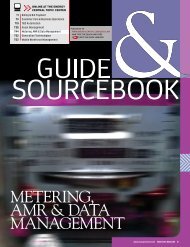utility systems automation - Description
utility systems automation - Description
utility systems automation - Description
Create successful ePaper yourself
Turn your PDF publications into a flip-book with our unique Google optimized e-Paper software.
Using the information in control room and dispatch<br />
operations to take preventive actions;<br />
Incorporating the measurement in taking actions<br />
automatically.<br />
BPA and its partners in the project primarily view WAMS as<br />
a diagnostic tool. This next step is to link network measurements<br />
into system controllers. BPA’s name for this project is<br />
Wide-Area Stability and Voltage Control System (WACS).<br />
Carson Taylor, BPA’s principal engineer for transmission,<br />
is heading up the WACS development. In BPA materials<br />
describing these innovations, Taylor indicated that together<br />
WAMS and WACS would change the nature of grid control.<br />
“Even the best operator can’t react quickly enough. This is<br />
where high-speed controls could take over, instantly analyzing<br />
troublesome trends, projecting their possible outcomes<br />
and initiating protection schemes to offset the problems.”<br />
Growing Interest<br />
WACS testing is expected to last for another year. Many of the<br />
principles developed by BPA’s WAMS and NYPA’s PMU projects<br />
are finding applications around the country. This past summer,<br />
for instance, the Eastern Interconnection Phasor Project<br />
(EIPP) went into effect, providing the first real-time, systemwide<br />
measurement of phase data for utilities throughout the<br />
Eastern Interconnect. Five control centers, located in or near<br />
St. Louis, Columbus, Ohio, Chattanooga, Tenn., New Orleans<br />
and Schenectady, N.Y., began sharing information via the EIPP<br />
network in August. The project will expand throughout the<br />
eastern system by the end of 2005.<br />
NYPA Research Chief Zelingher is watching the EIPP with<br />
great interest. “If we had all that kind of information available<br />
during the August 2003 blackout, people in control rooms<br />
would have had a much better idea of what was happening and<br />
could have acted on it,” he said.<br />
The eventual goal for wide-area <strong>systems</strong> is to be able to<br />
sense and correct for a variety of problems anywhere they<br />
might occur. In the meantime, engineers at the Salt River Project<br />
in Arizona are following a more specific grid strategy. According<br />
to John Blevins, SRP’s manager of engineering and planning, the<br />
sudden loss of two 1,200 MW units at the Palo Verde nuclear<br />
complex near Phoenix has the potential to ripple through the<br />
Western system, leading to an overload on the Pacific AC Intertie<br />
between California and Oregon. The California/Oregon Intertie is<br />
the major 500-kilovolt route for power transfers in the West.<br />
Palo Verde power is transferred into California via the 500-kilovolt<br />
Devers/Palo Verde Interties into Southern California.<br />
It’s not an unlikely scenario. Just this past summer, the<br />
Palo Verde nuclear plants tripped after a transmission line<br />
near Phoenix experienced a short-circuit. Utility customers<br />
as far away as Santa Clara, Calif., lost power as a result,<br />
although the COI remained intact.<br />
SRP has created a remedial action scheme (RAS) that<br />
would correct for a severe disturbance on the COI/Palo Verde<br />
corridors by automatically reducing load in the Phoenix area–<br />
thus reducing the chances of an overload in California. A network<br />
of 15 sensors is installed at the Palo Verde Generating<br />
Stations and 14 Phoenix-area locations. “They can sense a<br />
trip signal from one end of the system to another, all the way<br />
from California to Four Corners,” in New Mexico, Blevins said.<br />
The COI/Palo Verde RAS cost about $2 million in hardware<br />
and software, a bargain compared to constructing another<br />
high-voltage transmission line to reduce system stress. The<br />
next-step in this development will be to expand the sensor<br />
network to the territories of other Palo Verde plant owners in<br />
California and New Mexico, providing more flexibility in loadshedding<br />
responses.<br />
“This would not have been possible five years ago,” Blevins<br />
said. “This is one of the building blocks of a self-healing grid.”<br />
Distribution Visions<br />
Although much of the research and investment in “smart<br />
grid” technologies is being devoted to the high-voltage<br />
network, many of the same concepts are finding application<br />
at the <strong>utility</strong> distribution level. One such project is<br />
called Distribution Vision 2010 (DV 2010), a project conceived<br />
by WE Energies in Wisconsin and now has a dozen<br />
participants.<br />
Bob Huber, senior manager of research and development<br />
for WE Energies, noted that even though distribution substation<br />
<strong>automation</strong> is quite common in the industry, “There was<br />
a wall there; <strong>systems</strong> weren’t talking to each other.”<br />
The goal of DV 2010 is to develop a “plug and play” system<br />
that will be able to monitor localized networks for potential<br />
problems and correct them, without human intervention.<br />
The idea is to tie the separate functions of feeder network<br />
<strong>automation</strong>, dynamic voltage control and substation <strong>automation</strong><br />
into a coordinated system. This novel approach involves<br />
identifying a premium operating district (POD) that can be isolated<br />
from the rest of the network automatically when a fault<br />
occurs. By localizing and isolating the problem, <strong>utility</strong> crews<br />
can respond and correct the fault much more quickly.<br />
Success can be measured by reductions in the frequency<br />
and duration of outages. Customer benefits come in the form of<br />
improved reliability and power quality. Currently, there are three<br />
sites being tested by DV 2010 participants: a residential area<br />
near Milwaukee, an older industrial park at New Berlin in southeast<br />
Wisconsin, and at a commercial park in British Columbia.<br />
Although the “smart grid,” as conceived by EPRI and DOE,<br />
remains a goal to strive for, it’s clear to see how the many<br />
pieces of this “very large machine” are being tested and<br />
implemented throughout the nation and at all levels of the<br />
power delivery business.<br />
“The technology is mature and can be applied; it’s the application<br />
programs that need to be worked on,” Zelingher said.<br />
“The future is here. We need to make it happen now.”<br />
Arthur O’Donnell, AOD@energycentral.com, is senior editor<br />
of EnergyBiz.<br />
www.energycentral.com ENERGYBIZ MAGAZINE 47
















![View From the Trenches [PDF]](https://img.yumpu.com/18854438/1/190x252/view-from-the-trenches-pdf.jpg?quality=85)